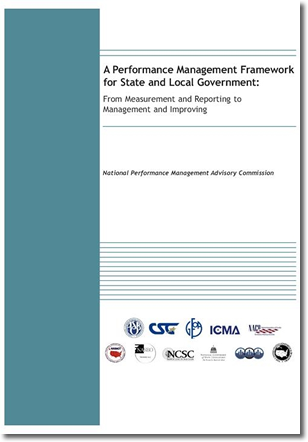
“At no time in modern history have state, local, and provincial governments been under greater pressure to provide results that matter to the public, often within severe resource constraints. At the same time, government officials and managers are challenged to overcome the public’s lack of trust in government at all levels.”
This opening statement from the foreword to A Performance Management Framework for State and Local Government: From Measurement and Reporting to Management and Improving, sets the stage for the recent release of the much-anticipated, 70-plus-page report from the National Performance Management Advisory Commission. A collaborative effort among 11 leading organizations representing local and state government (see box below), the report summarizes the Commission’s two years of research plus a four-month public review period.
A Performance Management Frameworkprovides a model for public sector performance management based on seven key principles, which can be applied to local government planning, budgeting, management, and evaluation to bring together critical processes and decision making to improve results. The seven principles ensure that
- A results focus permeates strategies, processes, the organization culture, and decisions. While compliance with prescribed processes can assure fairness, fiscal integrity, or adherence to the law, it does not necessarily result in substantial benefits to the public. Performance management assures that the organization’s culture and processes are aligned with the goals the organization wishes to achieve.
- Information, measures, goals, priorities, and activities are relevant to the priorities and well-being of the government and the community. To achieve results, an organization must first establish goals and performance targets that are relevant to stakeholders. It then must ensure that all levels of the organization (e.g., policy makers, managers, staff, and others) understand how to implement performance management tools that will achieve those goals.
- Information related to performance, decisions, regulations, and processes is transparent, i.e., easy to access, use, and understand. The transparency (i.e., completeness, organization, and understandability) of performance information is critical to fostering evidence-based planning, budget, and decision making.
- Goals, programs, activities, and resources are aligned with priorities and desired results. Effective performance management systems ensure alignment among an organization’s goals, priorities, programs, activities, resources, and desired results.
- Decisions and processes are driven by timely, accurate, and meaningful data. Collecting, storing, and applying performance data is essential to tracking and understanding results.
- Practices are sustainable over time and across organizational changes . “Performance management is not an event, a program, or a quick fix….” Efforts must be sustainable, flexible, and adaptable enough to keep up with inevitable changes, whether those changes take place within the organization’s leadership or the community in which the organization is located.
- Performance management transforms the organization, its management, and the policy-making process. An organization that has been truly transformed by performance management uses evidence-based planning and management, objective goal setting, and alignment of its structure, systems, and resources to achieve its desired results.
While an organization-wide commitment is ideal, limited efforts within a single division or department can also yield benefits. A Performance Management Framework discusses how, as with all improvement processes, implementation of either a limited or organization-wide performance management effort requires the ongoing involvement and drive of the organization’s leadership. The report highlights a dozen examples of successful local government performance management initiatives.
To download a copy of A Performance Management Framework for State and Local Government, click here.Additional information concerning the National Performance Management Advisory Commission, the 11 participating public sector management organizations, and future events related to the Commission will be posted at http://www.pmcommission.org in the coming weeks.
The members of the National Performance Management Advisory Commission are the Association of School Business Officials International (ABSCO); Council of State Governments (CSG); Government Finance Officers Association (GFOA); International City/County Management Association (ICMA); National Association of Counties (NACO); National Association of State Auditors, Comptrollers and Treasurers (NASACC); National Association of State Budget Officers (NASB); National Center for State Courts (NCSC); National Conference of State Legislatures (NCSL); National League of Cities (NLC); and U.S. Conference of Mayors (USCM).
ICMA was represented in this effort by Michael F. Brown, county executive officer, Santa Barbara County, California; Robert J. O’Neill, Jr., executive director, ICMA; and Michael W. Lawson, director, ICMA Center for Performance Measurement.
New, Reduced Membership Dues
A new, reduced dues rate is available for CAOs/ACAOs, along with additional discounts for those in smaller communities, has been implemented. Learn more and be sure to join or renew today!
